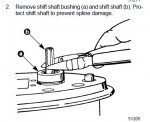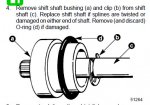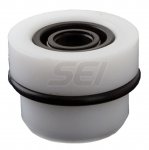Good afternoon, first time posting to the forum (that I can remember). I have a 60hp Mercury SN 0D186494, which I believe is a 1990. Came on a boat just purchased and when checking some items prior to handing over money, found water is gear housing. I was able to knock $1200 off the originally agreed upon price after that.
So first I did a pressure test on gear house per manual. Pressure did not hold as expected. I dropped the lower end and used soapy water spray top isolate leak. Too make doubly sure it was the only leak I did submerge in water test. Only leak found is at shift shaft. Parts diagram shows a shift shaft bushing that has an oil seal on inside and o-ring around bottom. The repair manual covers complete disassembly of gear housing and shift shaft is the last thing it covers. I can see removing the shift shaft potentially causing an issue if it is the only thing pulled out since the shift cam could potentially move when the shift shaft is pulled out of it.
Ideally, since I found no other leaks, I would like to not have the take apart the whole gear housing so I was wondering, before I start, if it is possible to remove the shift shaft bushing without removing the shift shaft so I can replace the oil seal and o-ring only. I dont know what it looks like yet since I will have to remove the water pump cover, gaskets, impeller and plate before it is exposed. So if it is something easy to just pop out or if there is a trick to getting it out without pulling the shift shaft, I would appreciate anyone who could tell me.
Thanks in advance.
So first I did a pressure test on gear house per manual. Pressure did not hold as expected. I dropped the lower end and used soapy water spray top isolate leak. Too make doubly sure it was the only leak I did submerge in water test. Only leak found is at shift shaft. Parts diagram shows a shift shaft bushing that has an oil seal on inside and o-ring around bottom. The repair manual covers complete disassembly of gear housing and shift shaft is the last thing it covers. I can see removing the shift shaft potentially causing an issue if it is the only thing pulled out since the shift cam could potentially move when the shift shaft is pulled out of it.
Ideally, since I found no other leaks, I would like to not have the take apart the whole gear housing so I was wondering, before I start, if it is possible to remove the shift shaft bushing without removing the shift shaft so I can replace the oil seal and o-ring only. I dont know what it looks like yet since I will have to remove the water pump cover, gaskets, impeller and plate before it is exposed. So if it is something easy to just pop out or if there is a trick to getting it out without pulling the shift shaft, I would appreciate anyone who could tell me.
Thanks in advance.
Last edited:























